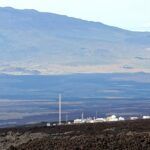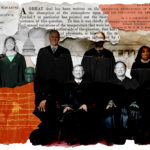Missing the forest for the trees: The role of forests in Earth’s climate goes far beyond carbon storage
By Sara Blichner, James Weber | May 16, 2024
 A foggy forest in Madeira, Portugal. (Photo by Fabrice Villard on Unsplash)
A foggy forest in Madeira, Portugal. (Photo by Fabrice Villard on Unsplash)
Imagine you’re in a forest. Do you feel soft pine needles underfoot? Or perhaps droplets of rain dripping down from the understory? Is it warm and wet, or cool and dry? What does it smell like?
Every forest has its own unique environment with cooling shade and particular smells, which can vary depending on the kind of forest, and whether it’s a warm and dry summer day, or if it’s been raining. The forest scent comes from a variety of organic vapors emitted by the trees and other plants, commonly referred to as biogenic volatile organic compounds (BVOCs). It is still a bit of a mystery why the trees emit these vapors, but proposed reasons include communication with other trees, attracting pollinators, protection against herbivores, heat-stress, and acting as antioxidants.
Although forests are widely understood to be a crucial carbon sink, these vapors can also impact the Earth’s climate in surprising and opposing ways. As the world warms, understanding these complex feedbacks is an essential piece of the climate puzzle.
Cooling haze and cloud-seeding particles. The fragrant vapors emitted by trees can react chemically in the atmosphere to form tiny particles, called aerosols (like those out of a can), which can reflect incoming solar radiation and thereby cause a cooling effect. The haze that forms is similar to those seen over cities like Los Angeles caused by man-made pollution, though much less dense.
These aerosol particles can also act as the starting point for cloud formation. Clouds are formed when air is lifted and cooled. When the relative humidity reaches 100 percent, water vapor will start to condense onto tiny aerosol particles in the air, forming cloud droplets. Every cloud droplet you see in the sky is formed around a pre-existing particle and the vapors from forests provide these particles. More particles lead to more cloud droplets, which in turn leads to brighter clouds which reflect more solar radiation back into space and cool the planet.
These particles from forests provide a natural version of cloud seeding, a topic which is receiving growing attention as a method to both induce more rainfall and increase cloud cover to provide local cooling.
Forests tend to respond to warmer temperatures by emitting more BVOCs, consequently forming more particles that shade and cool the planet’s surface. This means that forests may be counteracting the warming climate by creating a negative climate feedback, which acts to slow the warming. The feedback has been documented in observations both in boreal forests and in tropical forests.
This feedback is particularly important because burning fossil fuels releases both greenhouse gases and air pollutants that have temporary cooling effect. In fact, the latest IPCC report estimates that almost 30 percent of the warming from greenhouse gases has in fact been masked by aerosol particles. This means that measures to reduce the emissions of these particles to improve air quality, while great news for human health and the environment in general, simultaneously may already be leading to added warming in the near-term. Natural aerosol emissions, like those from BVOCs, may turn out to counteract some of this warming—but how much remains highly uncertain at present.
Warming by-products. But as with many things in nature, and life, there is no such thing as a free lunch. The same chemical reactions which the BVOCs undergo to produce aerosol also impact the greenhouse gases ozone and methane. These gases trap radiation emitted by the Earth and so warm the atmosphere. Unlike ozone in the stratosphere, or the upper atmosphere, which protects the surface from harmful solar radiation, ozone in the troposphere, the lower part of the atmosphere, is undesirable given its role as both a greenhouse gas and air pollutant. Generally, an increase in BVOC emissions will lead to more ozone production and a slower removal of methane as BVOCs react with the same gas which would otherwise destroy it (the hydroxyl radical). This leads to an increase in ozone and methane, driving a warming and opposing the cooling effect from aerosol and clouds.
The presence of these competing effects begs the central question: Which is stronger? To answer this, we use Earth System models which simulate all parts of the Earth System—the atmosphere, land surface, and ocean—to investigate how changes to BVOC emissions could affect our planet. Both the cooling and warming mechanisms are uncertain, and models disagree on their magnitude. The estimates of the BVOC-aerosol-cloud feedback range from completely negligible to being important on a global scale. One study found the negative (cooling) feedback from BVOCs producing aerosol was roughly twice the size of the positive feedback from ozone and methane changes. However, a more recent two-model study (led by co-author James Weber) on the effect of wide scale reforestation and afforestation found that the warming from ozone and methane largely cancelled out the cooling from aerosols, highlighting the uncertainty in the magnitude of the opposing effects.
In a recent study led by co-author Sara Blichner, published in Nature Communications, the BVOC-cloud feedback was evaluated in four different Earth System Models. The study examined how the models’ prediction of aerosols and cloud properties varied with temperature and compared them to observations to assess how good they might be at predicting the response to future warming. The models struggled to represent the feedback in the tropical forest, which is a very important region due to the high intensity of incoming solar radiation. They were better in the boreal forest, though also here tended to have compensating errors which reduce trust in the overall effect.
Overall, the results suggest that the feedback exists and is likely non-negligible but current models are quite far from representing it well and are most likely underestimating it—meaning that forests may be having a greater cooling effect than currently thought.
The root of the matter. So far, we have only considered the impact of increasing temperature on BVOC emissions and the knock-on effects to climate, but other factors will influence emissions as well. Afforestation and reforestation, popular ways to tackle climate change by increasing the removal of atmospheric carbon dioxide, will increase the BVOC emissions by increasing forest cover, while deforestation will do the opposite. Other environmental factors directly linked to climate change including floods, droughts, and heatwaves will also impact emissions. Human-driven increases to atmospheric carbon dioxide will likely increase tree biomass as they take up more carbon (“carbon dioxide-fertilization”) and therefore BVOC emissions. However, the magnitude of this so-called carbon dioxide-fertilization effect is uncertain and higher levels of carbon dioxide can also directly suppress the production of certain BVOCs from plants as well.
Another factor tied to forest area change is surface reflectivity, or albedo. Forests tend to be darker and therefore reflect less sunlight back out to space than non-forested areas, causing warming. In the particular forestation scenario considered in Weber et al. (2024), the albedo effect was larger than the impact of the aerosol, ozone, and methane changes and, when all these effects were combined, they reduced the net climate benefit of wide scale tree-planting by up to 30 percent.
The role of forests in the Earth’s future climate is going to increase from both natural processes (e.g., greater temperatures driving increased BVOC emissions) and anthropogenic policies, as efforts to halt deforestation and expand forests to absorb more carbon dioxide ramp up. Reducing air pollution means the influence of natural aerosols on climate will also grow. It is becoming increasingly clear that to assess the impact of these changes on climate, we need to refine further our understanding of the drivers and atmospheric impacts of BVOC emissions—particularly as a recent study suggests models may be underestimating the importance of aerosols from forests.
As is typical within climate science, such research is truly interdisciplinary, drawing on ecologists to understand natural and human drivers of forest cover change, plant biologists to examine the forest response to warming, atmospheric chemists to reduce uncertainties in ozone production and formation of atmospheric aerosols, and meteorologists to study the response of clouds. Forests will play a vital role in future change, but exactly how remains up in the air.
Together, we make the world safer.
The Bulletin elevates expert voices above the noise. But as an independent nonprofit organization, our operations depend on the support of readers like you. Help us continue to deliver quality journalism that holds leaders accountable. Your support of our work at any level is important. In return, we promise our coverage will be understandable, influential, vigilant, solution-oriented, and fair-minded. Together we can make a difference.
Keywords: climate research, climate science, deforestation, forestry, rainforests, re-forestation, reflectivity
Topics: Climate Change

















Thanks for the interesting article shedding light on the aerosols. However interestingly the main climate effect of forests, the cooling effect by water evaporation has not even been mentioned. Even the water evaporation cycle is a major energy carrier. When it’s mentioned that „ Forests tend to be darker and therefore reflect less sunlight ….“ (Weber 2024) this seems to neglect that the sun is not simply beeing absorbed by plants leading to a heat up effect – but that sunlight falling on a leaf triggers photosynthesis – means transfers radiation energy into chemical reaction and chemically stored energy (sugar… Read more »